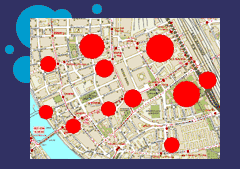 An attempt will be made to quantify the impact of using
the observed meteorological information on resulting concentration distributions as compared to using today's standard
procedures. For this task, not only the prognostic numerical model will employed but also
a Lagrangian particle dispersion models and simple Gaussian plume
dispersion models.
An attempt will be made to quantify the impact of using
the observed meteorological information on resulting concentration distributions as compared to using today's standard
procedures. For this task, not only the prognostic numerical model will employed but also
a Lagrangian particle dispersion models and simple Gaussian plume
dispersion models.
The experimental results will be used to thoroughly assess the existing parameterisations for the near-surface exchange of heat, momentum and pollutants. Some of these parameterisations are based on pure assumption (e.g., the description of the drag coefficient within the roughness elements) and are validated against limited full-scale data (e.g. the Reynolds stress profile in the RS). Other aspects are presently not taken into account at all (e.g., the heat flux divergence within the RS) due to completely missing data. The data will allow to validate and possibly improve all these parameterisations. Similarly, the simulations will allow to validate the modeled wind and turbulence fields in the bulk of the urban boundary layer and the resulting mixing height using the remote sensing data at various locations.
A full three-dimensional picture of the urban flow and turbulence structure and, in particular, the 'rural-urban transition' can only be obtained through numerical modeling. Typical (characteristic) flow configurations such as daytime vs. nighttime conditions under varying meteorological forcing can then be studied in detail.
The main result of the simulation part of the project will essentially consist of an extensively validated mesoscale model taking into account urban surface characteristics. This may be used primarily for dispersion simulations. However, it may also serve as a 'model' or guidance for improving NWP models (i.e., their surface exchange description) once their resolution is sufficiently good to allow for several grid point to be of urban character (as for the Swiss 'local model' this may be the case already within the duration of the project). In addition three-dimensional fields of flow and turbulence characteristics over an urban surface and the neighbouring rural surface will be available for further model evaluation and development.